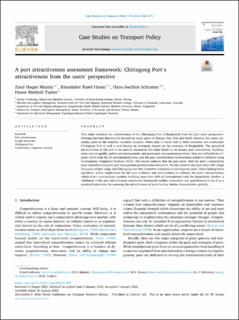| dc.contributor.author | Munim, Ziaul Haque | |
| dc.contributor.author | Hasan, Khandaker Rasel | |
| dc.contributor.author | Schramm, Hans-Joachim | |
| dc.contributor.author | Tusher, Hasan Mahbub | |
| dc.date.accessioned | 2022-05-09T13:03:03Z | |
| dc.date.available | 2022-05-09T13:03:03Z | |
| dc.date.created | 2022-01-25T07:12:20Z | |
| dc.date.issued | 2022 | |
| dc.identifier.citation | Munim, Z. H., Hasan, K. R., Schramm, H.-J. & Tusher, H. M. (2022). A port attractiveness assessment framework: Chittagong Port’s attractiveness from the users’ perspective. Case Studies on Transport Policy, 10(1), 463-471. | en_US |
| dc.identifier.issn | 2213-624X | |
| dc.identifier.uri | https://hdl.handle.net/11250/2994826 | |
| dc.description.abstract | This study evaluates the attractiveness of the Chittagong Port of Bangladesh from the port users’ perspective. Existing maritime literature is focused on major ports of Europe, East Asia and North America, but many secondary ports of the mainline maritime network, which play a crucial role in their countries, are overlooked. Chittagong Port is such a port having an enormous impact on the economy of Bangladesh. The perceived attractiveness of this port to its users is assessed in this study based on six factors: port connectivity, facilities, costs, service quality, policy and management, and green port management practices. Data are collected on a 7-point Likert scale for 25 measurement items, and the port attractiveness measurement model is validated using Confirmatory Composite Analysis (CCA). The results indicate that the port users’ find the port’s connectivity most attractive and green port management practices least attractive. We also observe that port users with a high frequency of port usage find Chittagong Port less attractive compared to less frequent users. These findings have significant policy implications for the port authority and policymakers to enhance the port’s attractiveness, which is in a monopolistic position handling more than 90% of international trade for Bangladesh. Further, a validation of the port attractiveness assessment framework enables researchers and practitioners to use it as a standard instrument for assessing the attractiveness of ports having similar characteristics globally. | en_US |
| dc.language.iso | eng | en_US |
| dc.rights | Navngivelse 4.0 Internasjonal | * |
| dc.rights.uri | http://creativecommons.org/licenses/by/4.0/deed.no | * |
| dc.title | A port attractiveness assessment framework: Chittagong Port’s attractiveness from the users’ perspective | en_US |
| dc.type | Peer reviewed | en_US |
| dc.type | Journal article | en_US |
| dc.description.version | publishedVersion | en_US |
| dc.rights.holder | © 2022 World Conference on Transport Research Society. | en_US |
| dc.source.pagenumber | 463-471 | en_US |
| dc.source.volume | 10 | en_US |
| dc.source.journal | Case Studies on Transport Policy | en_US |
| dc.source.issue | 1 | en_US |
| dc.identifier.doi | https://doi.org/10.1016/j.cstp.2022.01.007 | |
| dc.identifier.cristin | 1989053 | |
| cristin.ispublished | false | |
| cristin.fulltext | postprint | |
| cristin.qualitycode | 1 | |

